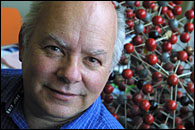Mineral namesake
Dr. Robert Martin is the latest McGill staff member to lend his name to a newly discovered mineral species. Martin's namesake, the appropriately dubbed "martinite," places the professor of geology in the esteemed company of such McGill luminaries as Frank Dawson Adams (adamsite), Thomas Henry Clark (thomasclarkite), Sir John William Dawson (dawsonite), John Johnston O'Neill (oneillite), and Sir Ernest Rutherford (rutherfordine) -- as well as two-time name donor Gabrielle Donnay (gaidonnayite and donnayite), and the mineral known simply as "mcgillite."
 Geology professor Robert Martin
Geology professor Robert MartinPHOTO: Owen Egan |
|
There are approximately 4,000 known minerals, and the Commission on New Minerals and Mineral Names of the International Mineralogical Association approves roughly 50 new ones each year. Pending IMA approval, martinite was known simply as UK-92. ("UK" is a temporary label meaning "unknown.")
Gilles Hainault, Peter Tarassoff and Laszlo Horvath ("three very dedicated amateur mineralogists," says Martin) discovered the rare mineral while digging on Mont Saint-Hilaire in September 1991. The martinite samples were unearthed in an igneous rock quarry, located on the opposite side of the mountain from the McGill-owned Gault Nature Reserve located 35 km east of Montreal. (Aside from its geological interest, igneous rock is a sought-after material for use in road construction and roofing.) Although the igneous body on Mont Saint-Hilaire is the same age as that of Mont Royal and other local formations, its igneous rocks are noteworthy because they were formed from a silicate melt which, through a long and involved sequence of geological processes, was "unusually enriched in all kinds of exotic elements." As a result, Martin says that Mont Saint-Hilaire is a geologist's delight, "one of the major mineral-collecting localities in the world." Aware of the area's significance, the quarry welcomes geologists one Saturday each month (May to October) to search for exposed minerals in freshly excavated areas.
Following its discovery, martinite was fully characterized by Professor Andrew M. McDonald of Laurentian University. Martinite, he reports, is a late-stage mineral which occurs as small tabular crystals (colours range from pale purple and pale yellow to colourless) and is a member of the Reyerite group. McDonald is a regular contributor to Canadian Mineralogist, the international journal edited by Martin for close to 20 years, and so decided to name the new mineral in honour of his colleague's distinguished career.
As per IMA regulations, martinite will only become truly official once McDonald publishes a paper detailing the mineral's characteristics. (He has a two-year window in which to do so.) There is no formal ceremony involved with having a mineral named after oneself. "But," quips Martin, "there may be a party.
"It's not like winning an Academy Award or anything like that," he adds. "But it is a sign of recognition of my involvement with the mineralogical sciences, of my contribution to Canadian Mineralogist, and of my own scientific work.
"It's an honour, and it's forever. After I'm gone, that name will keep on."To learn more about the unique mineralogical makeup of Mont Saint-Hilaire, visit the "History and Diversity of Quebec" exhibit in the Redpath Museum's Dawson Gallery. Plans are currently underway to expand the exhibit to include a new display illustrating the close ties between McGill staff and mineralogy.

